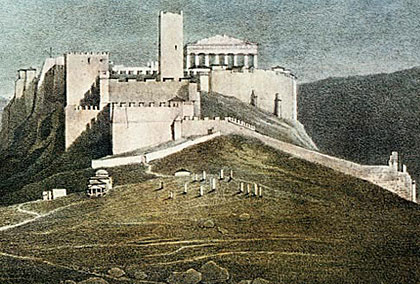 |
 PREFACE PREFACE
The view of modern Athens, if someone looks at it standing somewhere in one of the mountains that encircled the Athenian basin, is astonishing causing to observer a great amazement and different feelings. The city fills the whole area of the basin and expands even to the nearest mountains and hills proceeding out of natural borders. The huge semi white mass of box shape buildings is interrupted by disorderly spaces of plants. The curved lines of the vaults of churches are various without though changing the uniformity of the architectural lines. From this mass of buildings emerge the marvellous sacred hill of Acropolis and the group of the neighbouring hills and in dynamic contradiction the Lycabettus hill and the line of Brelessus hills namely Tourkovounia. It is also quite amazing the cathedral of Athens, which also has a specific architectural character. The metropolis of Athens was developed quite suddenly under the pressure of circumstances.
As a matter of fact, this city that seems suffering from gigantism lay inside the web of the ancient municipals. This view if different in nowadays because the city seems more massive instead of a group of smaller urban cells.
The modern city lives with a rat race rhythm and its urban structure offers restricted possibilities of walking and transportation. The walking in the city is restricted in specific urban zones despite the fact that offer a way out between the present and the historical past. Of course the inhabitants of Athens under the pressure of daily life, are not able to see the glorious past of the city.
However the Athenian past is obvious in every corner of the basin. Apart the illustrious monuments of antiquity, the elegant Byzantine churches and the neoclassic edifices, combined all together with the natural environment, consist the lively link between the past the present. The presence of the past is continuous in modern Athens and the evidences of historical continuity are quite rich.
The urban web of the city is still based on the ancient one. The roads and the axons of main streets are the same or following the axons of the ancient ones. Though the most impressive is the continuity in use of the urban area. And this is what is called historic sequel and continuation of Athenian landscape, which the inhabitant or the tourist has to know and live.
The National Foundation of Research having as main goal to provide the historic continuity of Athens had organised in 1994 a series of twelve tutorials with main issue the Archaeology of Athens. The twelve scholars presented the most crucial and important issues of the history of Athenian urban and suburban space from pre historic times to modern ones. The audience responding and attendance of those tutorials was amazing and hence the reports were published in a corpus under the wing of municipality of Athens. But this book was out of print very soon and therefore instead of republishing the Foundation decided to make a digital edition of the conference along with important additions to the texts and references from historical sources and pictures. The most important texts are translated in English too. The conference of Archaeology of Athens and the edition were take place under the wing of the programme “Society of Information”.
N. G. Moschonas
Director of Research, National Foundation of Research

|
 |